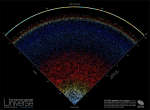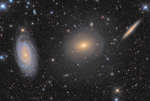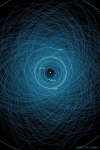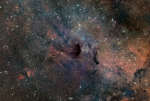
|
Astronomy Picture Of the Day (APOD)
 Fireworks vs Supermoon
Fireworks vs Supermoon
6.07.2023
On July 4, an almost Full Moon rose in planet Earth's evening skies. Also known as a Buck Moon, the full lunar phase (full on July 3 at 11:39 UTC) was near perigee, the closest point in the Moon's almost monthly orbit around planet Earth.
 APOD: 2023 July 5 B A Map of the Observable Universe
APOD: 2023 July 5 B A Map of the Observable Universe
5.07.2023
What if you could see out to the edge of the observable universe? You would see galaxies, galaxies, galaxies, and then, well, quasars, which are the bright centers of distant galaxies. To expand understanding...
 APOD: 2023 July 4 B Aurora over Icelandic Waterfall
APOD: 2023 July 4 B Aurora over Icelandic Waterfall
4.07.2023
It seemed like the sky exploded. The original idea was to photograph an aurora over a waterfall. After waiting for hours under opaque clouds, though, hope was running out. Others left. Then, unexpectedly, the clouds moved away.
 APOD: 2023 July 3 B Venus in Ultraviolet from Akatsuki
APOD: 2023 July 3 B Venus in Ultraviolet from Akatsuki
3.07.2023
Why is Venus so different from Earth? To help find out, Japan launched the robotic Akatsuki spacecraft which entered orbit around Venus late in 2015 after an unplanned five-year adventure around the inner Solar System.
 APOD: 2023 July 2 B Milky Way and Aurora over Antarctica
APOD: 2023 July 2 B Milky Way and Aurora over Antarctica
2.07.2023
It was one of the better skies of this long night. In parts of Antarctica, not only is it winter, but the Sun can spend weeks below the horizon. At China's Zhongshan Station, people sometimes venture out into the cold to photograph a spectacular night sky.
 Three Galaxies in Draco
Three Galaxies in Draco
1.07.2023
This tantalizing trio of galaxies sometimes called the Draco Group, is located in the northern constellation of (you guessed it) Draco, the Dragon. From left to right are face-on spiral NGC 5985, elliptical galaxy...
 APOD: 2023 June 30 B Orbits of Potentially Hazardous Asteroids
APOD: 2023 June 30 B Orbits of Potentially Hazardous Asteroids
30.06.2023
Are asteroids dangerous? Some are, but the likelihood of a dangerous asteroid striking the Earth during any given year is low. Because some past mass extinction events have been linked to asteroid impacts, however, humanity has made it a priority to find and catalog those asteroids that may one day affect life on Earth.
 APOD: 2023 June 29 B A Message from the Gravitational Universe
APOD: 2023 June 29 B A Message from the Gravitational Universe
29.06.2023
Monitoring 68 pulsars with very large radio telescopes, the North American Nanohertz Observatory for Gravitational Waves (NANOGrav) has uncovered evidence for the gravitational wave (GW) background by carefully measuring slight shifts in the arrival times of pulses. These shifts are correlated between different pulsars in a way that indicates that they are caused by GWs.
 Messier 24: Sagittarius Star Cloud
Messier 24: Sagittarius Star Cloud
28.06.2023
Unlike most entries in Charles Messier's famous catalog of deep sky objects, M24 is not a bright galaxy, star cluster, or nebula. It's a gap in nearby, obscuring interstellar dust clouds that allows a view of the distant stars in the Sagittarius spiral arm of our Milky Way galaxy.
 MAVEN s Ultraviolet Mars
MAVEN s Ultraviolet Mars
27.06.2023
These two global views of Mars were captured at ultraviolet wavelengths, beyond the spectrum visible to human eyes. Recorded by the MAVEN spacecraft's Imaging Ultraviolet Spectrograph instrument in July 2022 (left) and January 2023, three otherwise invisible ultraviolet bands are mapped into red, green, and blue colors.
|
January February March April May June |
|||||||||||||||||||||||||||||||||||||||||||||||||